Joel Leslie here, I’m bacckkkkkkkk…
Miss me? I missed you!
So I thought it MIGHT be interesting to show you a little bit about how a narrator can prep a script. It can be a very simple process, with a few marks, or, depending on the complexity of the project, almost like a musical score. Everyone does it differently, and it’s one of those things that over time each individual develops their favorite methods.
Now, what I’m going to talk about today is a pretty intense level of ‘scoring’ a script. Full disclosure this is NOT what I normally do when I’m working at home, in my pjs, able to make as many mistakes as I want and keep jumping back until I’m happy with each line. I am pretty SLOWWW as narrators go. I record about 18,000 words a day. That’s about two hours of finished audio and I’m in the booth from about 10am to 5pm. I’m finicky and didactic and I’ll keep recording things over and over until I’m happy. But I’ll usually do some kind of a markup.
One of the things that I’ve learned that really helps me is to highlight the end of a sentence. You can do it in ‘advanced search’ in Microsoft word by asking the document to find all the examples of a period followed by a space. This little trick helps me a LOT with charting my breathing. Sometimes there are authors that write reallllyyyyyyy long sentences. I kid Sloane Kennedy that somehow she always writes so I run out breath two words before she’s finishes a sentance. Having the highlighted sentence breaks shows me where the next chance to breathe will come and how much of a marathon I have to take to get through it…
Here’s something from Sloane…see the long sentences?
I can do those lines in one breath without rushing or compromising the emotion, but having a visual cue reminds me to take in a big supportive breath and prepare for a long, complex thought.
I use the Advanced Search for other tricks too. In NR Walker’s Red Dirt Heart series, she said that she really wanted Outback Aussie character Charlie to drop his final ‘ng’s. So ‘runnin’ instead of ‘running’. Plus the other character, Travis, was from Texas and he would do the same thing. When I first started recording I kept having a hell of a time remember to make the switch… so I figured out that I could highlight every ‘ing’ word in the manuscript.
Nifty, huh? The switch became reflex.
So that’s simple markup… But not to long ago I had a situation where I was doing a book for a major publisher and they wanted to have a director working over skype with me through the whole recording process. (TERRIFYING) It was my first big job with them, and I really didn’t want to come across as a buffoon. They wanted me to record the audio in about half the time I would normally schedule for myself. (Not because they were rushing me, but because I’m normally a perfectionist and slow). PLUS it was a Y/A project for Scholastic and I really wanted to do feel like I could deliver in the hours they scheduled but NOT feel like I had just rushed through and given them less than my best.
So… I had to prep the heck out of the book. I was very, very lucky to work with the late Katy Kellgren (one of the most extraordinary narrators EVER). Katy was a genius… she would spend two weeks prepping a single manuscript! She would study it as if she was going to be giving a live stage performance. It was extraordinary. I was lucky enough that she shared some of her mark-up techniques with me, and I utilized them extensively for this project. Katy passed away the week I was set to record this, and the last correspondence I had with her (when I was super nervous about doing this gig), was a little pep talk saying ‘You’re ready!”. I really miss her and with these tricks that I’ll use for years and years to come, I feel like she’s still with me.
Normally when you’re prepping a script you’ll figure out all the character voices (we’ve talked about that in a previous blog), check pronunciations of weird names and places, and make sure then when you start recording it’s smooth sailing. Most importantly, you’re pre-reading the script so you have a sense of the arc of the story and how to shape the narrative. In this case I had to go way beyond that, and really craft the shape of my performance and create signals for that would be a visual guide to know how to shape the performance and characterizations.
((So I’m not gonna mention the name of this book specifically because it hasn’t released yet… and I don’t want people to see spoilers. It’s not an m/m book so I figure we are ok between friends, right? After the release date I’ll come in and edit the blog post)))
I couldn’t get this particular script as a Microsoft word document, so through most of the manuscript, I marked most of the line breaks with a slash so my eye could plan ahead. If there was a moment where there was a gear shift, or a change of mood etc. I would mark it with a double slash so that I didn’t just barrel on as if it was part of the last thought.
For marking up a manuscript, personally I prefer an app called Notability. Some narrators prefer Iannotate, but I prefer the more freehand options of the former. Let me tell you, an apple pencil with an iPad Pro is the best thing to ever. It’s worth every penny for work like this.
One of the most obvious things is that I’ll assign a highlighter color to each character. And I’m really picky about which colors I choose for which character lol! Whenever you can use color as a trigger it helps because it keeps you WITH the text, rather than your eye having to process extra words as you’re reading. Here’s an example from another Y/A book, On Borrowed Luck by TJ Muir.
One thing I love about highlighting a character in a color is that it means you can scan the manuscript and easily pull out all of that character’s lines. When you are voicing a group of characters that don’t inherently have strong differences on the page or any specific descriptions, it can help you sense what makes them different from the characters around them. It’s great for group scenes, when you have a bunch of random pirates or something and you’re trying to assign different personalities.
In the example above you can also see some other fun little symbols that I use. My favorite is super silly and I stole it from high school Psychics class. It’s the symbol we were taught for a light bulb LOL. Soooo I use it to mark when a new idea or surprise is coming into the character or narrator’s mind. Eureka! (You can also think of it as a Scooby Doo moment).
Another thing that happens all the time is that the writer will describe the way a character says a line AFTER they say it. In the example above you can see it says “Aldon’s voice was less interested now”. So, before the line of dialogue preceding that, I marked ‘BORED’ (so that I didn’t get to the description and go ‘whoops’). In the previous image I did the same thing for a line of dialogue followed by ‘he mumbles’. Not rocket science, but it sure saves me having to go back and re-record dumb mistakes.
As a dialect coach I also teach people to use color to identify tricky vowels or sound shifts that are a consistent trouble spots or shifts that aren’t in the actor’s muscle memory. One really great thing about Notability for the iPad is that you can layer highlighting so that it gets darker and darker. So… for one Indian character I was able to highlighte all her dialogue in red but then further pull out the changes to the consonants p, b and t I needed to remember to adjust.
And you can also see how I’ve used a couple of phonetic symbols to remind me to make the sound switches.
In this example below, there’s an aristocratic German character who was from the royal family, so I wanted his ‘o’ sounds to always be very British. But unless I highlighted them I would miss them EVERY time. So each ‘o’ is in a darker orange color. In this scene that character is in conversation WITH the Indian character, so you can see how the colors really help your eyes not having to process hundreds of little scribbles over every inch of the page…
Sometimes if a character is saying something in a sing-song sarcastic way, i’ll use a little roller-coaster symbol or musical notes…
The little up arrow at the end of the sentance is another tool I’ll use to indicate a rising inflection or a lift to the end of the line. That one was taught to me by amazing Jedi narrator coach Sean Allen Pratt.
Or if a line gets stretched out… I’ll use these arrows…
Every once in a while I’ll make character notes in the margin to kick me into gear. For instance, at one point the author mentioned that the character introduced here ‘waddles’. That really helped me find his character. I noted that and quick casting reminders in the margin (They were two crotchety old scientists and I imagined a German Betty White, and the guy who played the Father in the movie Shine).
You’ll also see my brilliant acting directions to myself before certain lines like “hiss”… or “Boo!” But, for example, writing ‘URGENT’ before a line of dialogue really helps me.
I’ll also use musical notations sometimes… If a scene has a big build, or if a character is supposed to be getting louder and louder, I’ll use a traditional crescendo marking down the page…
You’ll also see words that I underlined words that I wanted to emphasize. Just scanning that sentence at the bottom, my brain would have wanted to emphasize ‘every’ but the Shakespearean structure of the speech needed me to build it a different way. Same with those rising inflections I have marked with arrows.
Sometimes when I needed to remember how to start the energy of a scene I would give myself a silly trigger reminder. Here I needed to make sure the character started straight away conveying a sense of anxiety and danger…
So for that gig I read the whole book once, just to get the sense of story. And then went through again and marked the heck out of it. Then I read it again, making sure i understood my markings and mouthing some of the trickier dialogue so that I made sure my mouth wouldn’t get tripped up. And, what normally would have taken me eight recording hours, we did in four. And, although I’m sure when I listen to the final project, I’ll keep saying “I could have done that better”… it was an amazing experience to be in the booth along with a director, listening, guiding, and helping you know when it’s ok to let go.
I don’t have the luxury of time to mark every script like in this detail, but it was a real joy as an actor to tackle a manuscript this way. And anytime I have to work under pressure, or in someone else’s studio on their clock, these tools save my life.
Hope you liked this little peek into my bizarre little brain.
xo
joel.
NEW RELEASES!!!
Spencer Cohen Book 2 by NR WALKER is out April 10!
Buried Passions by the amazing ANDREW GREY is out now!
I love your comments below… and all your ideas about what to discuss next!




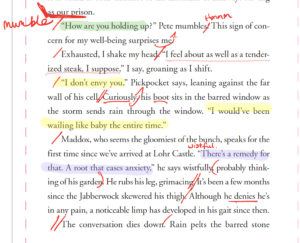
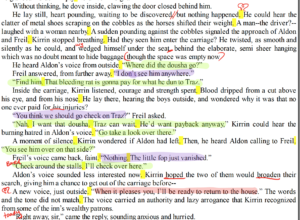

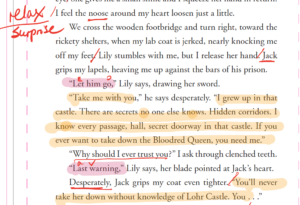


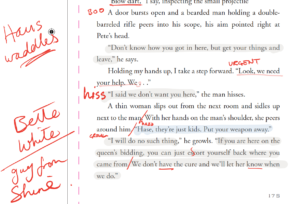
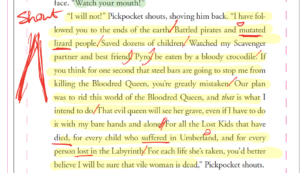
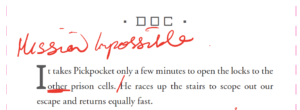
Wow, very interesting Joel, such a lot of work that shows in the finished products
Thanks suze… It’s kinda like a GPS for your mouth! lol.
Wow, really interesting stuff and it seems like a quite a lot to prepare for. Thank you for this very insightful post.
Thanks for sharing. I agree with the other two, it’s really interesting. I always wondered how narrators approached reading a book for an audience.
Wow! … just Wow! … each one of these posts just reiterates why you are a master at what you do, and why all of your books are just so good. Thanks again for sharing 🙂
I love reading about your process. It just reinforces for me how professional you are and why you are, hands-down, my favorite male audio performer. You are responsible for getting me hooked on audio. I thank you for that but my book budget doesn’t. 🙂